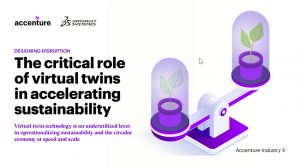Earlier this year, we shared the news that we collaborated with Accenture on a paper to advance the idea that virtual twins may hold the key to meeting the world’s sustainability goals. One aspect of Designing Disruption: The Critical Role of Virtual Twins in Accelerating Sustainability is an exploration into virtual twin use cases from five industries: construction, consumer packaged goods, transportation, life sciences, and electrical and electronics. The report discovered that these examples alone have the potential to unlock more than 7.5Gt of CO2e emissions reductions through 2030 and US$1.3 trillion of economic value.
You can discover the full paper here. But in this post, we are taking a deeper look into one of the five industries: consumer packaged goods, or CPG.
Did you know design decisions can be linked to 80% of a product’s environmental impact?

CPG products make up 2/3 of international trade volume and 10% of the US GDP. Being such a large and diverse market means the industry faces significant challenges to achieving sustainability. Virtual twin experiences can help play a key role in addressing these challenges, by allowing for digital testing of if/then scenarios early in the design process. This information creates a wealth of knowledge and visibility, allowing cross-functional teams to make informed decisions about how to minimize a product’s impact on the environment, including using fewer raw materials and wasted resources during the manufacturing process.
In addition to optimizing design decisions to improve a product’s impact on the environment, these decisions can also improve product cost; 60-85% of which is determined in the early stages of design. Applying virtual design and prototyping software with built-in LCA tools helps designers both iterate design cycles faster and reduce the need for physical testing – so not just good for the environment but also for reducing cost. Specifically, the report’s case study found the potential for:
- USD $131 Bn reduction in raw material usage costs
- USD $6 Bn reduction in product development costs
- 281 Mt CO2e reduction in embedded product footprint as a result of better LCA output visibility and improved decision-making as a result
And it’s not only the goods themselves that can benefit from virtual twin experiences: the factories where CPG products are produced and the processes by which they’re made can be optimized in virtual twins, too. The virtual twins help optimize designs for better manufacturing production and management software, production line layout and material flows as well as enable the modeling and simulating of discrete production processes or entire factories. Through this, plant operators gain enormous amounts of information to analyze, helping to discover productivity improvements, ways to reduce costs and make production processes more efficient, flexible and less resource-intensive per unit of output.
Virtual twins also help CPG companies optimize the sustainability impacts of their supply chains through increased transparency and visibility. Being able to see the entire process even outside of their own organization helps a manufacturer more fully understand, measure and reduce their environmental or social footprint. For example, a virtual twin can help create a more sustainable logistics plan by running different scenarios for delivery options to determine which has the least impact on emissions, considering aspects such as driving distance, vehicle type, road type, local carbon taxes, etc.
 Download the paper now to get more insights on the nascent role of virtual twin experiences in the CPG industry, including how implementing such technologies across plants can support digital skills transformation in the workforce. You’ll also more broadly discover how virtual twin technologies can deliver significant sustainable innovation at scale in order to achieve the UN SDGs and redesign the global economy to be more circular and low carbon.
Download the paper now to get more insights on the nascent role of virtual twin experiences in the CPG industry, including how implementing such technologies across plants can support digital skills transformation in the workforce. You’ll also more broadly discover how virtual twin technologies can deliver significant sustainable innovation at scale in order to achieve the UN SDGs and redesign the global economy to be more circular and low carbon.
Learn even more on our page Deliver Innovative Sustainable Packaging with Cutting-Edge Science.

